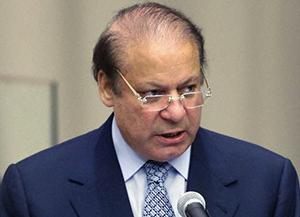Islamabad, Oct 5: Pakistan Prime Minister Nawaz Sharif today hit back at his Indian counterpart Narendra Modi, saying poverty cannot be eradicated by "driving tanks on farmlands" and once again needled India by calling Hizbul commander Burhan Wani a "son of the Kashmiri soil".
Responding to Modi's speech last month challenging Pakistan to a contest over eradicating poverty and other social ills, Sharif said, "If they (Indian leaders) want us to fight them to end poverty, then they should realise that poverty cannot be eradicated by driving tanks on farmlands."
Sharif, while addressing a joint session of the Parliament convened to discuss the security situation in the wake of increasing Indo-Pak tensions, accused India of running away from dialogue and instead creating a war-like environment by blaming Pakistan for the Uri terror attack in which 19 Indian soldiers were killed last month.
"We have done everything to make India come to the dialogue table, but India did not let it happen. Our efforts were thwarted over and over again," Sharif claimed. "Without any investigation (into Uri incident), within a few hours, India blamed Pakistan for the attack," he said.
Sharif accused India of having some "motives" in blaming Pakistan for the Uri attack when it was "not even established" that who was involved in it. The Pakistan Prime Minister also accused India of violating the LoC ceasefire agreement and launching "aggression" against Pakistan.
"India's ceasefire violation resulted in the death of our two soldiers, when it attacked Pakistan. It was befittingly responded and was conveyed that Pakistan Army is fully capable to respond to any aggression," he said.
Sharif also expressed support for Kashmiris and said the issue should be resolved according to the wishes of people of Kashmir and the UN resolutions. "The Kashmiri youth have taken it upon themselves to carry on the movement of freedom against Indian aggression and atrocities," Sharif said.
He again mentioned Wani in his speech. "The death of Burhan Wani, son of the Kashmiri soil, had reminded India to give Kashmiris their right to self-determination," Sharif said. Raking up Kashmir at the UN General Assembly, Sharif had called Wani a "young leader", evoking a strong reaction from India. Wani was killed in an encounter with security forces on July 8, sparking off protests in the Valley.
Lambasting Sharif's "glorification" of Wani in his UNGA speech, India had said hailing a "self-advertised" terrorist at the forum is "self-incrimination" by the Pakistani leader. Sharif, in his address to the Parliament today, urged the international community to play a role in implementing the UN resolutions on Kashmir.
He claimed that India wanted to deflect the world from its "acts of suppression" in Kashmir by leveling allegations against Pakistan. He asserted that Pakistan's armed forces were fully prepared and ready to thwart any attack.
All opposition parties attended the joint session except Imran Khan's Pakistan Tehreek-i-Insaf as the cricketer-turned politician had boycotted it, saying Sharif was not fit to lead the country and the session would only endorse his leadership.
Sharif's comments came after last month, while speaking at a public meeting in Kerala held on the sidelines of the BJP national council meet, Prime Minister Modi had said, "I accept this challenge. I want to tell you that India wants to fight with Pakistan. If you have the courage then why not fight to end poverty, unemployment, illiteracy. Let us see which country wins, India or Pakistan."





Comments
Add new comment